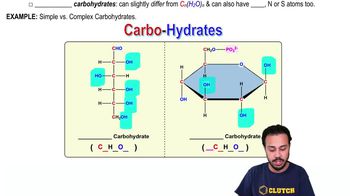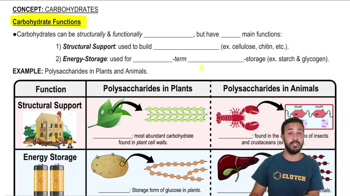4. Biomolecules
Carbohydrates
Learn with other creators
Practice this topic
- Multiple Choice
Which of the following chemical formulas represents that of a simple carbohydrate?
5340views89rank - Multiple Choice
Monosaccharides are linked together via a ______________ reaction, forming a _____________bond.
5358views56rank - Multiple Choice
Which of the following chemical reactions results in energy release when glycosidic bonds are broken?
5039views59rank - Multiple Choice
Animal cells store energy in the form of _________, and plant cells store energy in the form of ___________.
6024views48rank - Textbook Question
Which of the following categories includes all others in the list?
a. Disaccharide
b. Polysaccharide
c. Starch
d. Carbohydrate
2468views1rank - Textbook Question
What are three ways monosaccharides differ from one another?
1716views - Textbook Question
The enzyme amylase can break glycosidic linkages between glucose monomers only if the monomers are in the α form. Which of the following could amylase break down?
a. glycogen, starch, and amylopectin
b. glycogen and cellulose
c. cellulose and chitin
d. starch, chitin, and cellulose
4165views - Textbook Question
A glucose molecule is to starch as (Explain your answer.)
a. A steroid is to a lipid
b. A protein is to an amino acid
c. A nucleic acid is to a polypeptide
d. A nucleotide is to a nucleic acid
2826views













